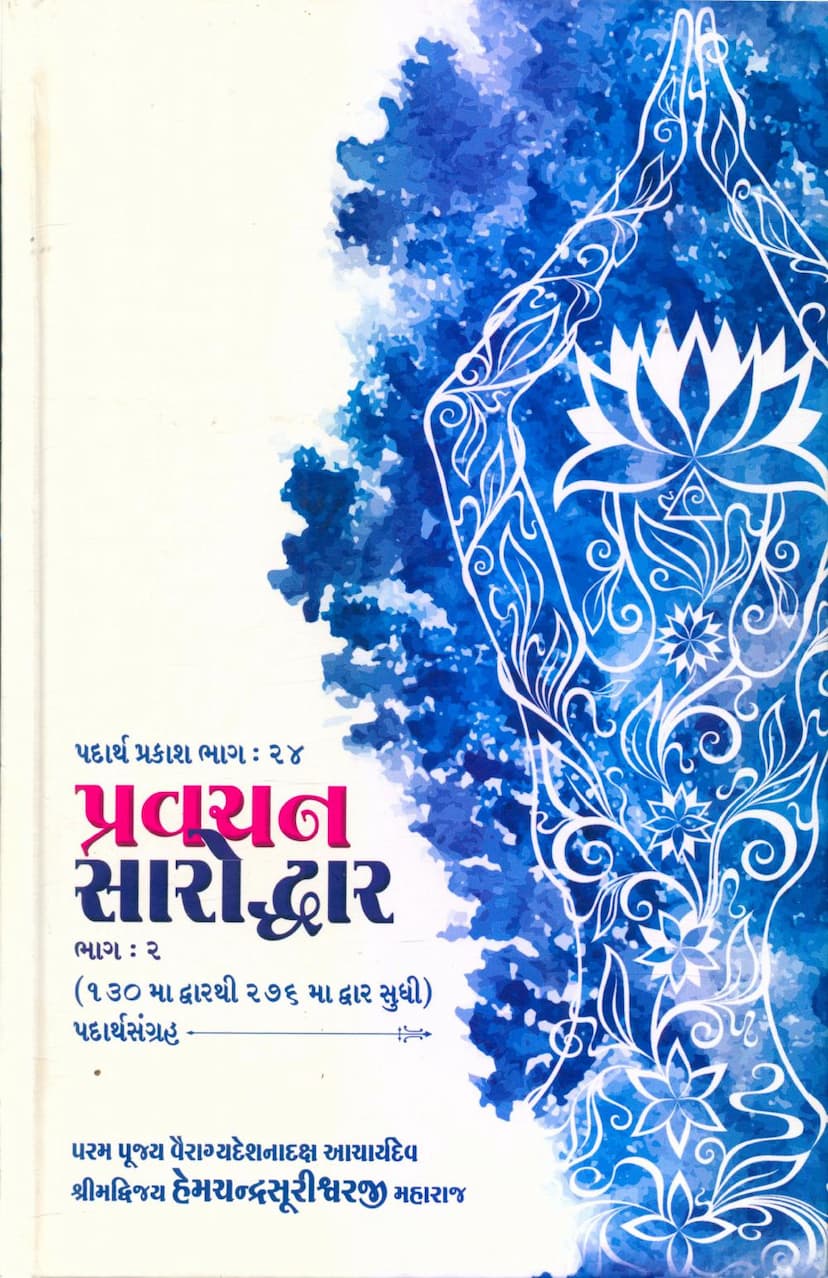Padarth Prakash 24 Pravachan Saroddhar Part 02
Added to library: September 2, 2025

Summary
This document is the second part of the "Padarth Prakash" series, specifically Volume 24, titled "Pravachan Saroddhar Part 02." It covers "Padarth Sangrah" from Door #130 to Door #276, based on the original "Pravachan Saroddhar" composed by Shri Nemichandrasuri and commented upon by Shri Siddhasen Suriji. The work is attributed to the compilation and editing of Acharyadev Shrimad Vijay Hemchandrasurishwarji Maharaj.
The publisher is Sanghvi Ambalal Ratanchand Jain Dharmik Trust, and the founder is Shraddhavarya Muliben Ambalal Shah. The first edition was published in Veer Samvat 2542 / Vikram Samvat 2072 / 2016 CE, with a print run of 500 copies, priced at Rs. 200.
The book is dedicated to the holy feet of Acharyadev Shrimad Vijay Premsurishwarji Maharaj, Acharyadev Shrimad Vijay Bhuvan Bhanusurishwarji Maharaj, and Panyas Pravar Shri Padmavijayji Maharaj, with blessings from Gachhadhipati Acharyadev Shrimad Vijay Jayghoshsurishwarji Maharaj and the author, Acharyadev Shrimad Vijay Hemchandrasurishwarji Maharaj. Gratitude is expressed to the dikshit members of the family and the individuals and entities involved in the printing and typesetting.
The "Prakashiya" (editorial note) highlights that this series aims to present Jain philosophical concepts ("Padarth") in a simple and easily understandable manner, making these profound topics accessible to knowledge-seekers. The book is praised for its clarity, use of illustrations, and tables to aid understanding.
The content itself is structured as a compendium of "Pravachan Saroddhar," covering various topics through "Dwar" (Doors or sections) numbered from 130 to 276. The index provides a glimpse into the vast range of subjects discussed, including:
- Practices and Observances: Service to the Guru, washing of possessions, rules for eating, purity of living spaces, rules for ascetics (like 12-year Sallekhana).
- Cosmology and Geography: Concepts of time (three periods), substances (six dravyas), world structure (Lok Swaroop), continents and oceans.
- Life and Beings: Classification of souls, types of life forms, lifespans, origination of beings, characteristics of hell beings (naraka), celestial beings (deva), and humans/animals (tiriyanch).
- Jain Doctrine: Principles of Right Faith (Samyaktva) and its various classifications, vows of lay followers (Shrवक), sins and virtues, types of conduct (bhava), and stages of spiritual progress (Gunsthanak).
- Karma Theory: The eight karmas and their sub-categories (158 in total), the processes of bondage (bandh), manifestation (uday), elicitation (udirna), and potentiality (satta).
- Time and Measurement: Concepts of P Palyopam, Sagropam, and their vast calculations, as well as the measurement of space (Angul).
- Historical and Mythological Figures: Mention of Chakravartis, Baladevas, Vasudevas, Pratichakravartis, and their associated jewels and treasures.
- Ethical and Behavioral Guidelines: Types of speech (4 languages, 16 types of utterances), sins (18 Pap Sthanak), virtues (27 Sadhu Gun, 21 Shravak Gun), emotions (8 types of pride), and the importance of right conduct.
- Specific Concepts: The 10 Wonders of the Jain world, types of months and years, the nature of the universe, the significance of different types of speech, and the concept of "Sankhya" (enumeration).
The document also provides detailed explanations of complex concepts, such as the different types of Samyaktva, the elaborate classifications of souls, the intricacies of karma, and the structure of the Jain universe. The text emphasizes the importance of adherence to Jain principles, the renunciation of worldly desires, and the path to liberation through right faith, knowledge, and conduct. The detailed listing of "Dwar" (Doors) indicates a systematic and comprehensive approach to presenting Jain philosophy.
The latter part of the document delves into the specifics of various concepts, including different types of hellish realms, the lifespan and characteristics of celestial beings, the intricate details of the structure of the Jain universe, the numbers associated with souls in different categories, the exact specifications of the 84 lakh life forms, the different types of knowledge and perception, and the stages of spiritual development. The detailed enumeration of karmas, their subdivisions, and the states of their bondage, manifestation, and potentiality underscores the scientific rigor of Jain metaphysics.
The concluding sections discuss the various types of ascetics' and lay followers' conduct, the causes of sin, the different stages of spiritual development (Gunsthanak), the characteristics of hellish beings and celestial beings, the concept of Samyaktva (Right Faith), the types of knowledge, and the subtle aspects of karmic processes. The detailed descriptions of measurements, time cycles, and classifications of beings reflect a profound cosmological and ontological understanding within Jainism.
Overall, "Padarth Prakash Part 02" is a scholarly and comprehensive work that expounds on core Jain philosophical tenets, offering detailed explanations and classifications of numerous spiritual, cosmological, and ethical concepts within the Jain tradition.